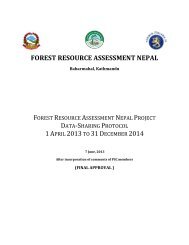Download - FRA Nepal
Download - FRA Nepal
Download - FRA Nepal
Create successful ePaper yourself
Turn your PDF publications into a flip-book with our unique Google optimized e-Paper software.
Land-use is one of the key issues in making a new forest policy. The decision of land-use and respective forest management<br />
regime is one of the most important outcomes of the forest policy formulation process. The starting point is the present landuse,<br />
which should be detected as one variable of the <strong>FRA</strong>. If possible, wall-to-wall map should be produced presenting the<br />
prevailing land-use pattern. Tabular and some geographic data can be obtained from the field plots and from the very high<br />
resolution remote sensing plots (images).<br />
The OSFIS is designed using standard software development process and in close co-operation with local IT company chosen<br />
in an open bidding process. Following three steps are covered in close communication with the end-users:<br />
1. Determination of System Requirements (Tasks: describe approaches to requirements determination, participate<br />
Joint Application Design sessions and use prototyping during requirements determination);<br />
2. Structuring System Process Requirements (Tasks: draw data flow diagrams, prepare use cases and use case);<br />
3. Structuring System Data Requirements (Tasks: prepare a conceptual data model - draw an entity-relationship<br />
(E-R) diagram or a class diagrams);<br />
Finally, the chosen local IT Company will compose the system and design technical databases, forms, maps and reports as<br />
well as interfaces and dialogues. The produced map layers have to be carefully thought and designed to meet the data needs.<br />
This is one of the key components of the project. The list of desired maps can be long and each map layer should be given a<br />
priority class. The realisation should start from high priority map layers. A preliminary list of map layers is suggested below<br />
as an example.<br />
Primary maps in<br />
national and regional<br />
data production<br />
1. Interpretation of Forest and shrubland areas (Ownership, Land-use, Forest<br />
type/habitat, Degradation, Volume -, Age -, Biomass-, Carbon classes)<br />
2. Ortho-rectified satellite images in compressed format for viewing (sid/ECW)<br />
3. Topographic map, scale 1:50,000, 1:25,000<br />
4. Cadastral Map and database (when available)<br />
Environmental maps 1. National parks, wildlife reserves and conservation areas<br />
2. Wetland that signify important for national biodiversity<br />
3. Water courses, watershed areas<br />
4. Areas with high risks of landslides and erosion<br />
Maps for Analysis 1. Statistical socio-economical maps, <strong>Nepal</strong> Info<br />
2. Administrative maps<br />
3. Transportation maps (road network)<br />
4. Old Land use maps and forest resource maps (LRMP, NFI 1998)<br />
Reporting is implemented by using some standard reporting software, such as Seagate Crystal Reports. The test versions of<br />
the program will be constantly evaluated together with officers in charge. Their feedback is taken into account to improve the<br />
functionality of the software. The first output will be software for field inventory result computing to be adopted and used by<br />
inventory data users. The second output will be GIS based OSFIS to integrate data sources within the Ministry of Forests and<br />
Soil Conservation.<br />
This component will be started 4 months after launching the project. Implementation will take 8 months during 24 working<br />
months. The pilot inventory software is provided before the end of the first year. The GIS based Open Source Forest<br />
Information System will be available after second year.<br />
7.4.2.1 Output and timetable<br />
Duty / Product<br />
Timetable<br />
Description of the system: system requirements, data flow, data model 1 st year<br />
Definition and ranking of map layers 1 st year<br />
Realization of Integrated GIS based FIS 2 nd to 3 rd year, on-going<br />
The project staffs responsible for implementation:<br />
STA, Senior Data Management Adviser (Regional), Forest Information system and Remote Sensing Expert with local ITcompany<br />
and national counterparts are responsible.<br />
33





